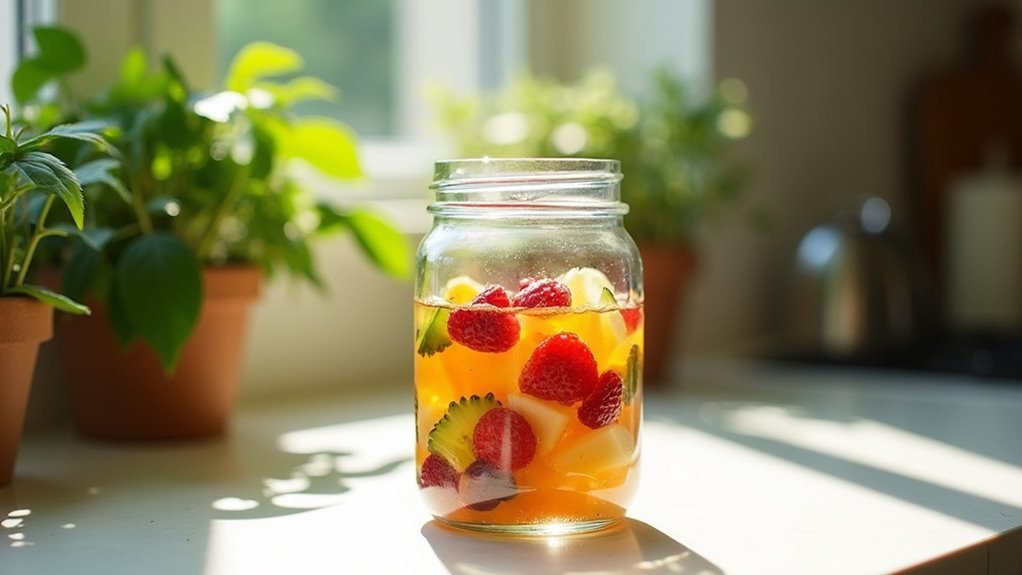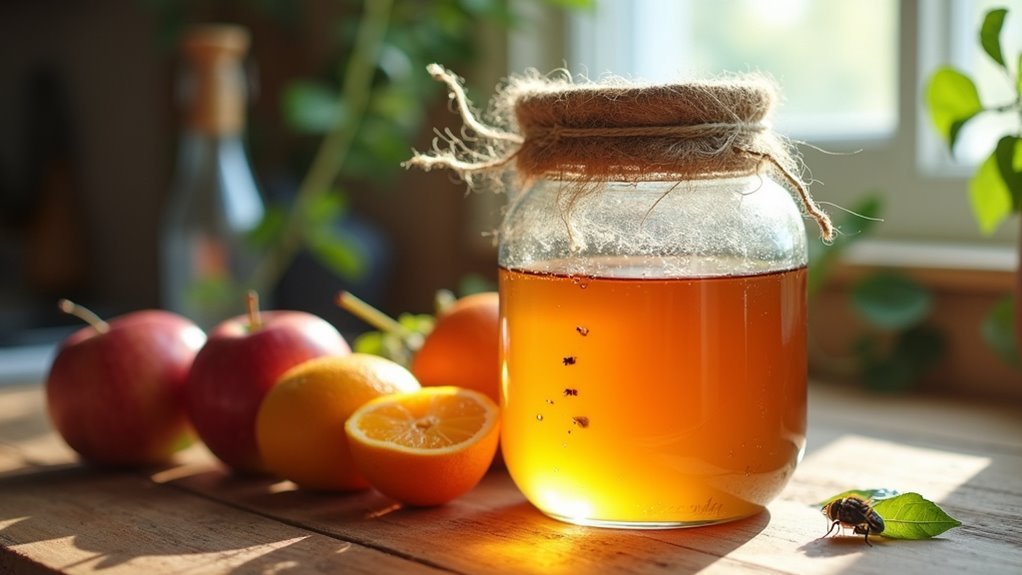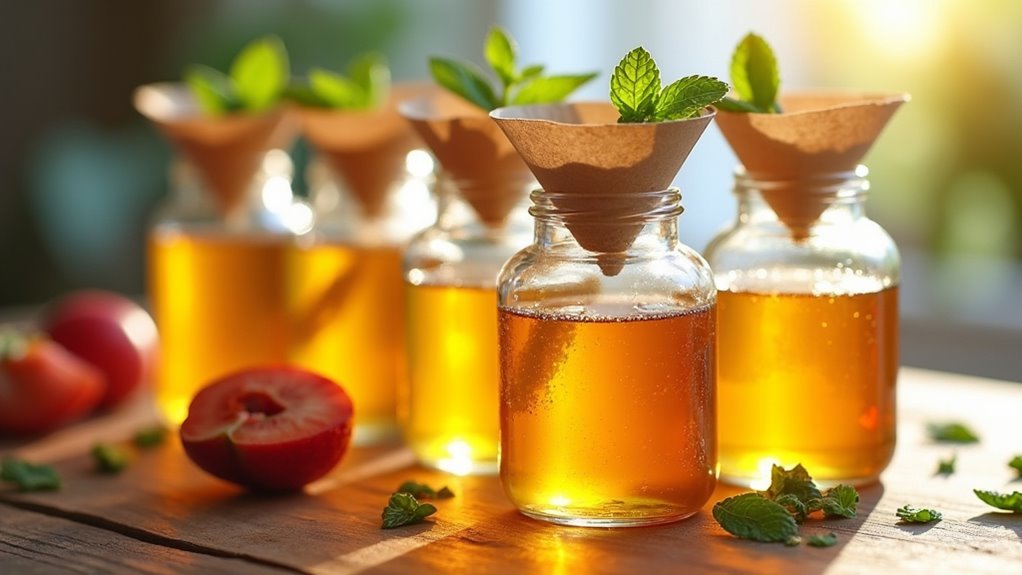You can create effective pet-safe fruit fly traps using apple cider vinegar, overripe fruit, or sugar water as natural bait ingredients that won’t harm your furry friends. Simply fill a jar with apple cider vinegar, cover it with punctured plastic wrap, and place it on high shelves away from pets’ reach. Add a drop of dish soap to prevent flies from escaping, and replace the mixture every few days for best results. These simple methods will help you discover countless ways to protect both your home and beloved animals.
Why Pet Safety Matters When Choosing Fruit Fly Traps

When you’re dealing with a fruit fly infestation, your first instinct might be to grab the strongest trap available, but this approach can put your furry family members at risk.
Pet safety should be your top priority when selecting fruit fly traps, as conventional options often contain harsh chemicals that pose serious health threats to curious animals.
If your pet ingests or inhales toxic substances from commercial traps, they could experience poisoning, respiratory issues, or digestive problems.
This risk is especially high for cats and dogs who explore their environment through taste and smell.
Choosing fruit fly traps with non-toxic ingredients protects your pets while still effectively eliminating the pest problem, creating a safer home environment for everyone.
Essential Ingredients for Non-Toxic Fruit Fly Bait
Now that you understand why pet safety matters, you’ll want to know which ingredients work best for creating effective, non-toxic fruit fly trap bait.
Apple cider vinegar stands out as the top choice, attracting flies with its fermented scent while remaining completely safe. Add a few drops of dish soap to break surface tension and trap the insects effectively.
Overripe fruits like bananas or peaches create powerful natural baits with their strong aroma.
Red wine mixed with dish soap offers another excellent option, as yeast attracts fruit flies seeking fermentation.
For sweet-loving flies, combine lemon juice with sugar water—this mixture can be safely used around kids and pets without worry.
These simple ingredients guarantee you’ll eliminate fruit flies while protecting your family.
Apple Cider Vinegar Jar Trap Method

The simplest and most effective pet-safe fruit fly trap requires just three household items: apple cider vinegar, plastic wrap, and a rubber band.
Pour about one inch of apple cider vinegar into a jar—the fermented scent naturally attracts fruit flies. Cover the jar’s opening with plastic wrap and secure it tightly with a rubber band.
Use a toothpick to poke several small holes in the plastic wrap. These holes allow fruit flies to enter but prevent their escape.
This apple cider vinegar fruit fly trap uses completely non-toxic ingredients, making it safe around children and pets.
Check your trap daily and dispose of captured flies. Replace the vinegar every two weeks to maintain effectiveness and keep attracting new fruit flies.
Wine Bottle Funnel Trap Design
You can create an effective fruit fly trap using an empty wine bottle and a simple paper funnel that guides flies in but prevents their escape.
This method requires just cutting the top off a plastic bottle or rolling paper into a cone shape, then placing it in the wine bottle’s neck with apple cider vinegar as bait.
The design’s completely pet-safe since it doesn’t use any harsh chemicals, making it ideal for homes with children and animals.
Simple Assembly Steps
Five simple steps will transform an empty wine bottle into an effective fruit fly catcher that’s completely safe for your pets.
First, pour apple cider vinegar into your empty wine bottle as bait. Next, cut a funnel from paper or cardboard with an opening large enough for flies to enter but small enough to prevent escape. Insert the funnel snugly into the bottle’s neck to seal entry points.
| Step | Action | Purpose |
|---|---|---|
| 1-2 | Add vinegar, create funnel | Attract flies, control entry |
| 3-4 | Insert funnel, position trap | Prevent escape, maximize catches |
| 5 | Monitor and refresh | Maintain effectiveness |
Place your trap near fruit bowls or garbage cans where flies congregate. This easy to use design remains safe to use around pets while effectively eliminating pests.
Safety for Pets
Beyond proper setup, pet owners can confidently use this wine bottle trap knowing it poses minimal risk to their furry companions. The pet-safe design relies on natural apple cider vinegar bait that won’t harm pets if they ingest small amounts.
However, you’ll want to position the trap where curious animals can’t tip it over or access the contents directly.
When used as directed, the funnel design effectively prevents flies from escaping while keeping pets out. Check your trap regularly to monitor flies caught and replace bait before it spoils. This prevents pets from accessing decomposing insects or rancid liquid.
The eco-friendly approach eliminates chemical concerns entirely, making it ideal for pet households seeking effective fruit fly control without compromising their animals’ safety.
Plastic Wrap Punctured Lid Technique

You’ll need just a jar, apple cider vinegar, plastic wrap, and a toothpick to create this effective trap that won’t harm your pets.
The hole size you poke matters greatly—make them large enough for flies to enter easily but small enough to confuse their escape route.
Strategic placement near fruit bowls or garbage areas maximizes your trap’s effectiveness while keeping it safely away from curious pets.
Materials and Setup
Creating an effective pet-safe fruit fly trap with the plastic wrap punctured lid technique requires just a few common household items.
You’ll need a glass jar, apple cider vinegar, dish soap, plastic wrap, and a toothpick. This setup is completely safe AROUND KIDS AND PETS since it uses non-toxic ingredients.
Start by filling your jar with apple cider vinegar, adding just a few drops of dish soap to break surface tension.
Stretch plastic wrap tightly over the jar’s opening, securing it around the rim without gaps. Use your toothpick to puncture small entry holes – they should allow flies in but prevent escape.
This simple setup effectively addresses your fruit fly problem when positioned strategically near common breeding areas like fruit bowls or sinks.
Hole Size Importance
While your trap’s overall design matters, the hole size you create determines whether fruit flies become permanent captives or temporary visitors. The precise diameter directly impacts trap effectiveness, making this detail essential for success.
You’ll want to punch holes approximately 1/8 inch in diameter. This size allows fruit flies to enter while preventing their escape. Users who nail this measurement often catch 8-10 flies per trap.
Here’s your optimization strategy:
- Start with 1/8-inch diameter holes as your baseline
- Monitor catches for the first few days to assess performance
- Adjust hole size smaller if you notice flies escaping
- Experiment with slight variations to maximize your specific trap’s effectiveness
Consistent monitoring helps you fine-tune dimensions, ensuring your trap maintains peak performance throughout its use.
Placement for Effectiveness
Getting your hole size right means nothing if you place your plastic wrap trap in the wrong location.
Strategic placement dramatically impacts your trap’s success rate in capturing fruit flies.
Position your trap near ripening fruits where fruit flies naturally congregate. Countertops displaying bananas, tomatoes, or other produce create ideal placement zones.
Kitchen sinks also attract these pests due to moisture and food residue.
Areas where fruit flies are frequently spotted deserve immediate trap placement. Don’t randomly position traps throughout your home—focus on high-activity zones where you’ve observed the most fruit fly traffic.
Your trap’s effectiveness depends on mimicking their preferred environment. Place it close to their food sources and breeding grounds for maximum capture rates, ensuring you’re intercepting their natural flight patterns.
Mason Jar With Drilled Holes Approach
Among the most effective DIY fruit fly solutions, the Mason jar with drilled holes approach consistently delivers impressive results. This pet-safe method traps fruit flies using simple household materials while keeping your family protected from harmful chemicals.
Creating your Mason jar trap involves these steps:
- Drill small holes in the jar’s lid to allow entry but prevent escape.
- Fill with apple cider vinegar and add several drops of dish soap as bait.
- Place the trap near fruit fly activity areas for maximum effectiveness.
- Use dark or opaque jars to hide trapped insects and maintain kitchen aesthetics.
You’ll catch over 50 fruit flies per use, dramatically reducing infestations. The non-toxic ingredients make this solution completely safe around children and pets when positioned appropriately.
Sugar and Vinegar Bowl Trap Setup
Another highly effective pet-safe option combines sugar and apple cider vinegar to create an irresistible lure for fruit flies.
Mix equal parts of these ingredients in a bowl to attract pests with the sweet scent while the vinegar enhances the appeal. Cover the bowl with plastic wrap and secure it using a rubber band. Poke small holes in the wrap that allow fruit flies to enter but prevent their escape.
Create a simple trap by covering the bowl with plastic wrap, securing with a rubber band, and poking small entry holes.
Position your trap near problem areas like ripe fruits, garbage cans, or kitchen sinks for maximum effectiveness.
This sugar and vinegar method offers a completely natural approach that’s safe around pets and children. You’ll avoid harsh chemicals while creating an eco-friendly solution using common household ingredients for sustainable pest management.
Placement Strategies to Keep Pets Away From Traps
You’ll want to position your fruit fly traps in locations that effectively target flies while staying completely out of your pet’s reach.
High shelves, spaces behind appliances, and cabinet interiors offer excellent placement options that keep curious pets safe from trap contents.
These strategic locations maintain trap effectiveness while creating physical barriers between your pets and potentially harmful bait materials.
High Shelf Trap Positioning
When dealing with fruit flies while keeping your pets safe, strategic placement of traps on high shelves and elevated surfaces becomes your most effective defense mechanism.
High shelf trap positioning guarantees your pets can’t accidentally contact traps while maintaining proximity to fruit fly hotspots like kitchen sinks and fruit bowls.
Maximize your trap effectiveness with these positioning strategies:
- Countertop corners – Place traps in back corners where pets can’t reach but flies congregate
- Wall-mounted shelves – Install dedicated shelving near problem areas to secure traps permanently
- Cabinet tops – Utilize space above appliances for discreet, elevated trap placement
- Hanging positions – Choose compact, hanging-style traps that dangle safely above pet level
Monitor traps regularly from a distance, guaranteeing they’re functioning properly without requiring close interaction that might compromise pet safety.
Behind Appliance Placement
Behind appliances offers prime real estate for fruit fly traps that pets can’t access.
Position traps behind refrigerators, dishwashers, or stoves where fruit flies congregate but remain hidden from curious animals. Use non-slip mats or stabilizing containers to prevent traps from tipping over when pets explore nearby areas.
Apple cider vinegar makes an excellent natural bait that’s safe for pets when used properly in covered trap designs.
Choose fruit fly traps with enclosed systems or non-toxic ingredients to minimize risks if your pet somehow reaches them. The gaps behind appliances provide perfect concealment while maintaining trap effectiveness.
Monitor these locations regularly to verify traps stay clean and functional.
This strategic placement keeps pets away from trapped insects and bait materials while targeting high-traffic fly zones.
Cabinet Interior Locations
Cabinet interiors provide secure locations that effectively isolate fruit fly traps from pet interference while maintaining strategic positioning near problem areas.
You’ll find these enclosed spaces perfect for targeting fruit fly hotspots while keeping curious pets safely away from trapping mechanisms.
When implementing cabinet traps, follow these essential guidelines:
- Position traps away from pet-accessible items like food storage to minimize accidental contact risks.
- Choose pet-safe traps with natural ingredients that won’t harm pets if they somehow gain access.
- Use opaque containers to conceal trap contents and reduce pet curiosity about what’s inside.
- Monitor and replace traps regularly while ensuring pets remain restricted from cabinet access during maintenance.
This placement strategy maximizes effectiveness while prioritizing your pet’s safety through physical separation and controlled access.
Natural Ingredients That Attract Flies Without Harming Pets
Since you’re concerned about your pet’s safety, you’ll be relieved to know that several natural ingredients can effectively attract fruit flies without posing any health risks to your furry companions.
Apple cider vinegar works exceptionally well due to its strong scent that draws flies into traps without using harmful chemicals. You can also use ethyl lactate, a plant-based ingredient that’s completely non-toxic around pets.
Malic acid, naturally found in fruits, creates another safe option for homemade traps. A simple sugar-water mixture provides excellent bait when placed in controlled environments.
These natural ingredients allow you to attract the flies while maintaining a completely safe space for your pets, proving you don’t need toxic chemicals for effective pest control.
Maintenance and Cleaning Tips for Homemade Traps
While creating effective pet-safe fruit fly traps is just the first step, maintaining them properly guarantees they’ll continue working at peak efficiency.
Regular cleaning and maintenance prevent these traps from becoming ineffective breeding grounds for bacteria.
Follow these essential maintenance steps:
- Replace traps every few days or when you notice significant numbers of trapped flies to verify continuous effectiveness.
- Clean containers thoroughly with warm, soapy water after disposing of old bait to prevent mold growth and deterrent odors.
- Add dish soap drops to apple cider vinegar traps to break surface tension and prevent flies from escaping.
- Store unused traps in cool, dark places to preserve bait freshness and avoid attracting other insects.
Monitor your traps regularly and adjust bait or designs based on observed fly activity for ideal results.
Frequently Asked Questions
How to Get Rid of Fruit Flies Without Harming Pets?
You can eliminate fruit flies safely by mixing apple cider vinegar with dish soap in jars, using commercial pet-safe traps, or creating DIY vinegar-fruit bowls covered with punctured plastic wrap placed away from pets.
What Is the Best Homemade Fruit Fly Trap?
You’ll get best results using a jar with holes punched in the lid and apple cider vinegar as bait. This method captured over 50 fruit flies in testing, outperforming other homemade options.
Which Bait Works Best for a Homemade Fruit Fly Trap?
You’ll find apple cider vinegar works best as bait for homemade fruit fly traps. Add a drop of dish soap to break surface tension, preventing flies from escaping once they’re attracted to the fermenting scent.
Does White Vinegar and Dish Soap Get Rid of Fruit Flies?
Yes, you’ll catch fruit flies effectively with white vinegar and dish soap. The vinegar’s scent attracts them while the soap reduces surface tension, trapping flies when they land and can’t escape.
In Summary
You’ve now got several pet-safe options to tackle your fruit fly problem without worrying about your furry friends’ safety. Remember to place traps in areas your pets can’t reach, refresh the bait regularly, and clean thoroughly between uses. These natural methods won’t harm your animals while effectively eliminating those pesky flies. Start with the apple cider vinegar trap—it’s simple, effective, and completely safe for your household pets.





Leave a Reply